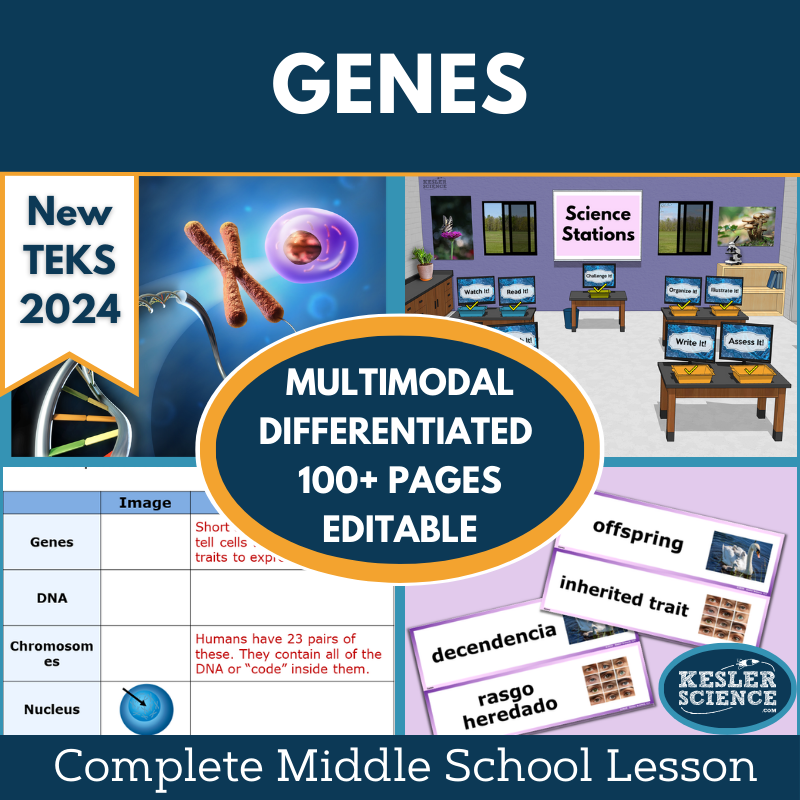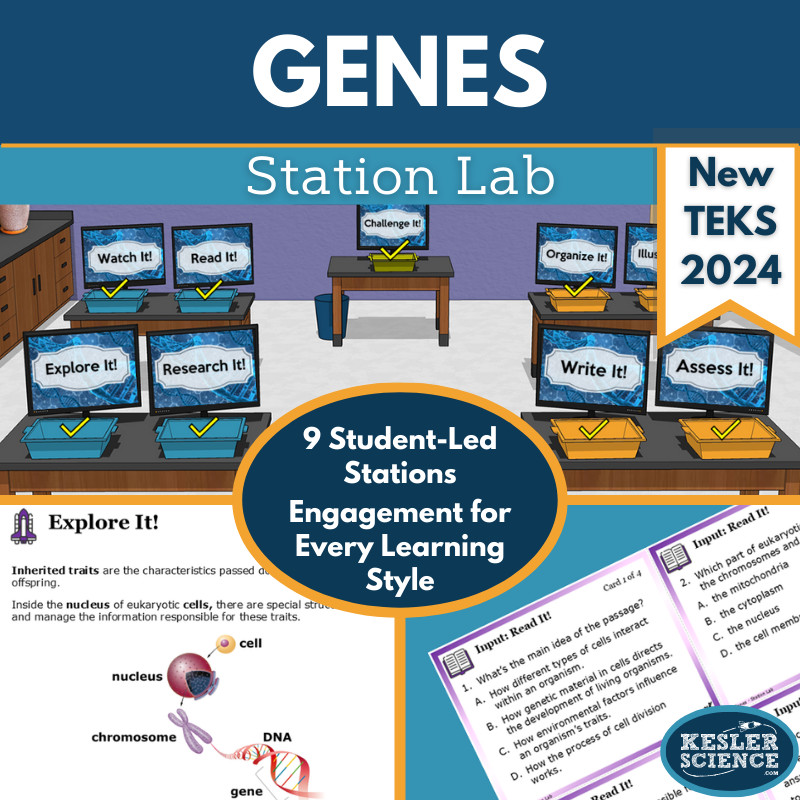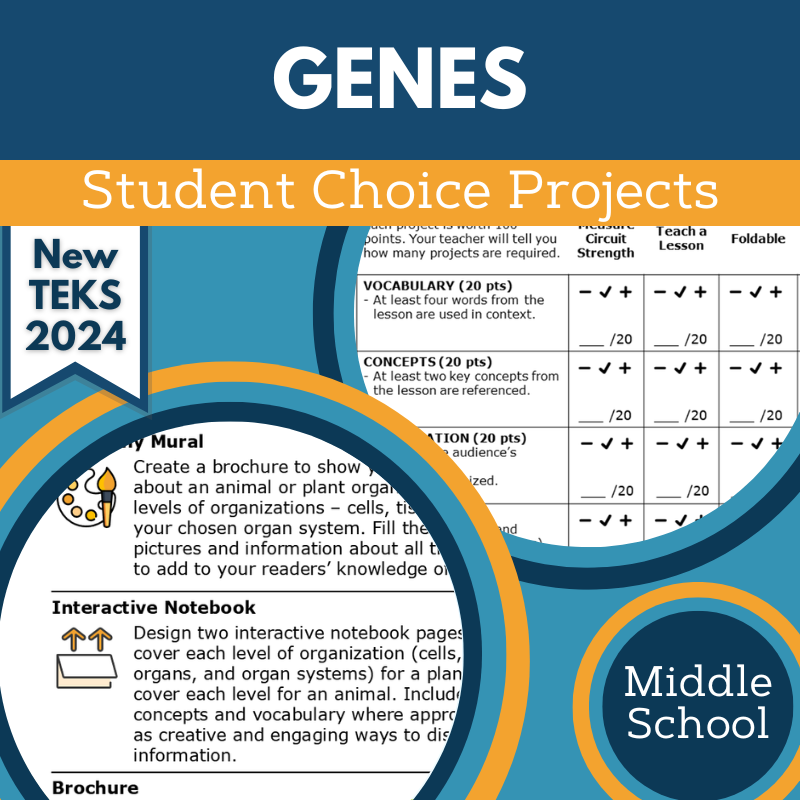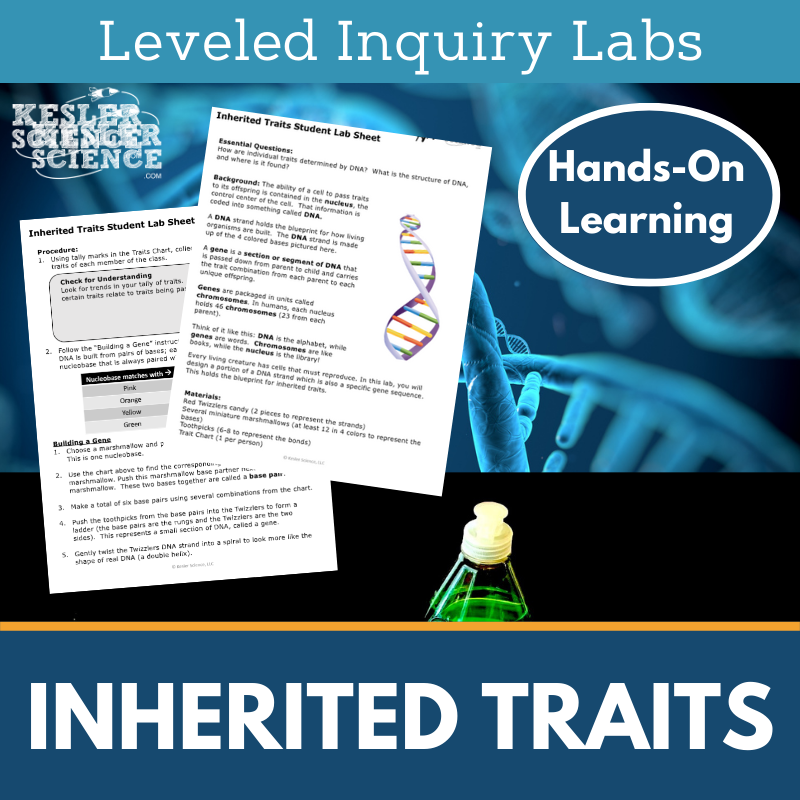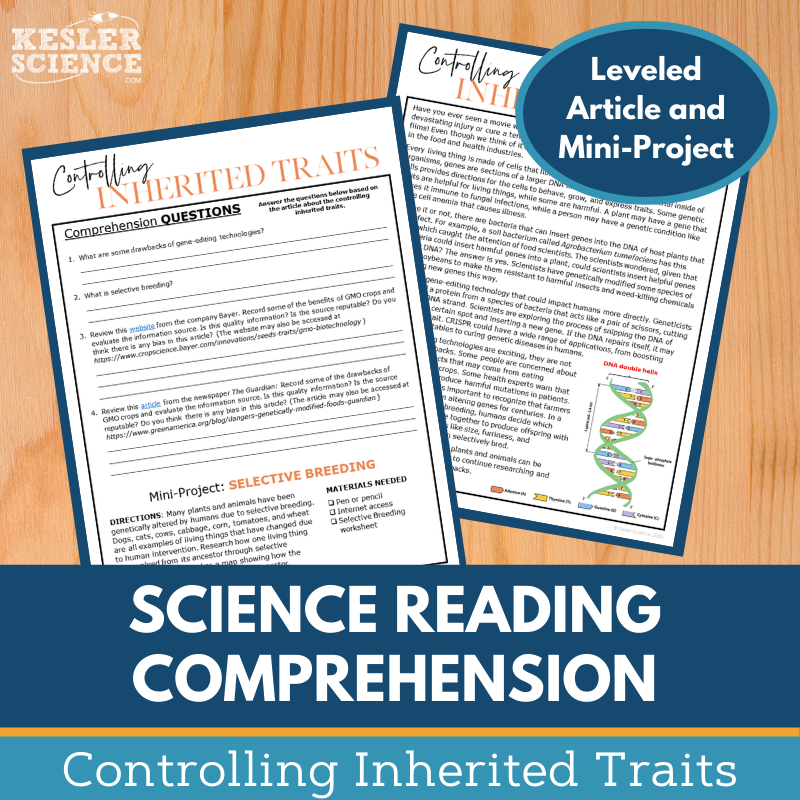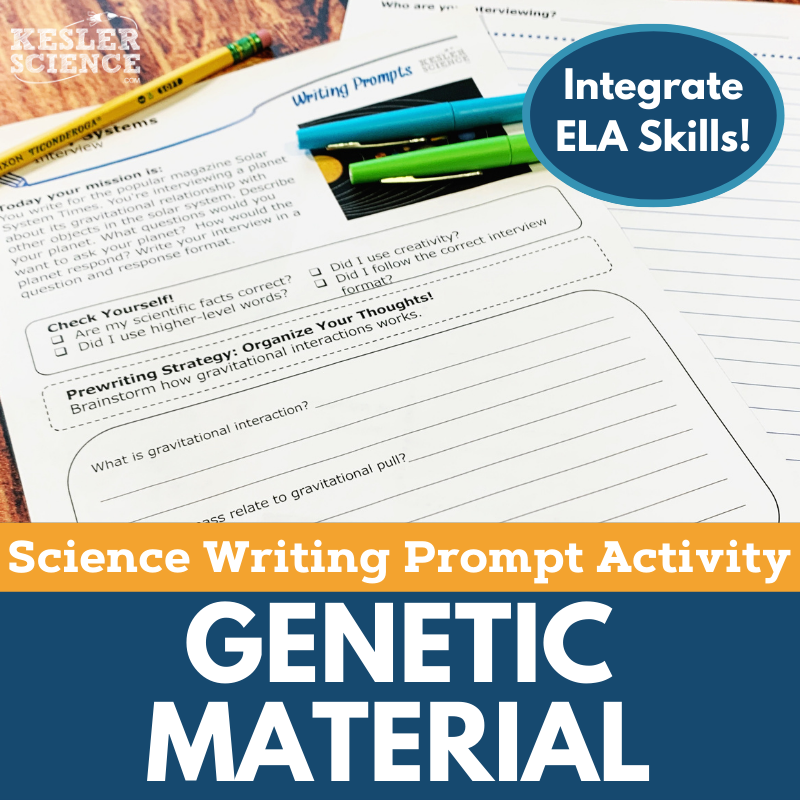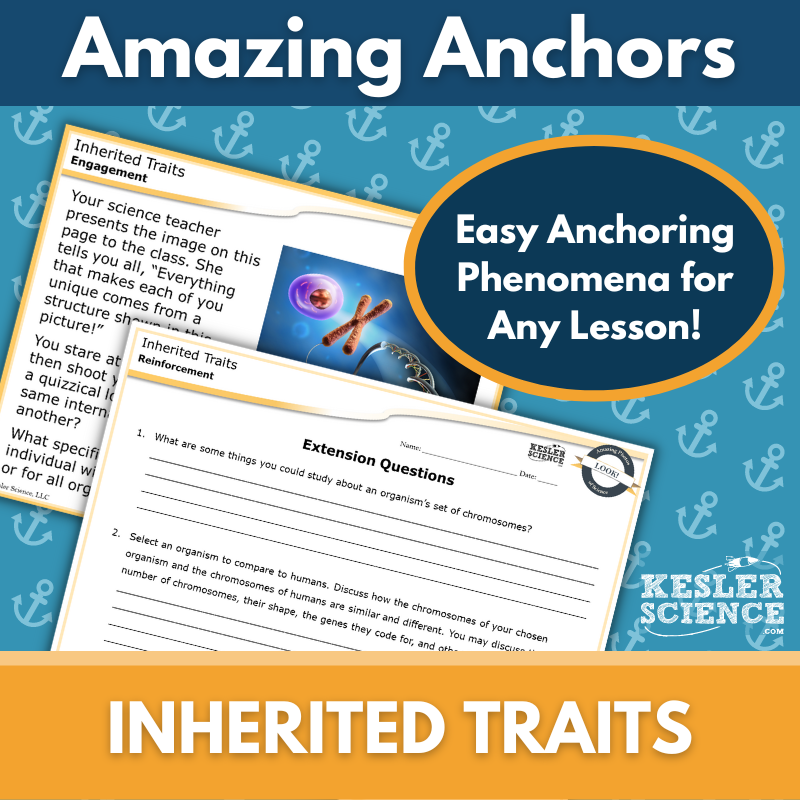Genes Activities for Middle School Science
Grasping how genes influence inherited traits can be challenging for middle school students, but these engaging materials simplify the concept! The resources below will give students a comprehensive understanding of genes. All of the following materials are also included in the Kesler Science Membership.
The Kesler Science Genes 5E lesson is a complete middle school life science unit designed to help students describe the function of genes within chromosomes in determining inherited traits. This fully editable unit includes PowerPoint presentations, worksheets, differentiated station labs, and assessments to support student-led learning. With multimodal resources, Spanish translations, and flexible digital and print formats, this lesson ensures accessibility for all learners while aligning with the 2021 TEKS 8.13B standard.
Using the 5E Model, the lesson provides structured engagement, exploration, explanation, elaboration, and evaluation. Students participate in hands-on activities, reading passages, research tasks, and videos in the differentiated station lab to explore how genes, DNA, and chromosomes work together to influence traits. Editable PowerPoints and interactive notebooks in English and Spanish support direct instruction, while student-choice projects and discussion-based reviews reinforce understanding. Assessment materials, including STAAR 2.0-aligned questions, offer both dependent and modified versions for varied learning needs.
Designed for maximum flexibility, this unit works seamlessly for in-class or virtual learning. Students can engage with station labs, interactive notebooks, and choice projects in a format that fits their learning environment. Whether used as a stand-alone lesson or part of a larger curriculum, this resource provides the tools needed to foster a deeper understanding of genetics and inherited traits in middle school students.
The Kesler Science Genes 5E lesson is a complete middle school life science unit designed to help students describe the function of genes within chromosomes in determining inherited traits. This fully editable unit includes PowerPoint presentations, worksheets, differentiated station labs, and assessments to support student-led learning. With multimodal resources, Spanish translations, and flexible digital and print formats, this lesson ensures accessibility for all learners while aligning with the 2021 TEKS 8.13B standard.
Using the 5E Model, the lesson provides structured engagement, exploration, explanation, elaboration, and evaluation. Students participate in hands-on activities, reading passages, research tasks, and videos in the differentiated station lab to explore how genes, DNA, and chromosomes work together to influence traits. Editable PowerPoints and interactive notebooks in English and Spanish support direct instruction, while student-choice projects and discussion-based reviews reinforce understanding. Assessment materials, including STAAR 2.0-aligned questions, offer both dependent and modified versions for varied learning needs.
Designed for maximum flexibility, this unit works seamlessly for in-class or virtual learning. Students can engage with station labs, interactive notebooks, and choice projects in a format that fits their learning environment. Whether used as a stand-alone lesson or part of a larger curriculum, this resource provides the tools needed to foster a deeper understanding of genetics and inherited traits in middle school students.
Engage your students with this student-led Genes Station Lab aligned with the 2021 TEKS standards. Designed for in-class or virtual learning, this interactive resource helps students explore the function of genes within chromosomes and how they determine inherited traits. With nine differentiated stations, students actively engage through hands-on activities, videos, readings, and research while directing their own learning.
Students demonstrate their understanding by organizing information, illustrating models, writing responses, and completing assessments. The bonus Challenge It! station provides extension activities for advanced learners, and differentiated reading passages in English and Spanish ensure accessibility for all students. This station lab is also included in the Structure of Life Station Lab Bundle.
This low-prep, high-engagement resource promotes critical thinking and independent learning. With all materials, task cards, and digital options available in PowerPoint and Google Slides, this flexible and comprehensive lab is the perfect way to reinforce key genetics concepts in your life science classroom.
Engage your students with this student-led Genes Station Lab aligned with the 2021 TEKS standards. Designed for in-class or virtual learning, this interactive resource helps students explore the function of genes within chromosomes and how they determine inherited traits. With nine differentiated stations, students actively engage through hands-on activities, videos, readings, and research while directing their own learning.
Students demonstrate their understanding by organizing information, illustrating models, writing responses, and completing assessments. The bonus Challenge It! station provides extension activities for advanced learners, and differentiated reading passages in English and Spanish ensure accessibility for all students. This station lab is also included in the Structure of Life Station Lab Bundle.
This low-prep, high-engagement resource promotes critical thinking and independent learning. With all materials, task cards, and digital options available in PowerPoint and Google Slides, this flexible and comprehensive lab is the perfect way to reinforce key genetics concepts in your life science classroom.
The Genes Student Choice Projects align with the 2021 TEKS 8.13B standard, giving middle school students the freedom to select a project that best matches their learning style. A project page outlines six student-led options plus a “design your own” project, all supported by an editable rubric for teacher, peer, or self-assessment. This resource is also included in the Genes Complete Lesson for TEKS 8.13B.
These flexible, multimodal projects encourage creativity and personalized learning, allowing students to demonstrate their understanding of genes, chromosomes, and inherited traits in unique ways. Two versions of the project page support differentiation, offering modified options for students who need additional support and challenges for advanced learners. Teachers can easily adjust the rubric to fit their grading criteria.
Designed for convenience, the projects use common classroom supplies like paper, markers, and scissors, with many options available for digital completion. Also available in the Structure of Life Bundle (six topics for grades 6-8) and the MEGA Student Choice Project Bundle (84 topics) for grades 6-8, this resource provides an engaging and adaptable way for students to showcase their knowledge of genetics.
The Genes Student Choice Projects align with the 2021 TEKS 8.13B standard, giving middle school students the freedom to select a project that best matches their learning style. A project page outlines six student-led options plus a “design your own” project, all supported by an editable rubric for teacher, peer, or self-assessment. This resource is also included in the Genes Complete Lesson for TEKS 8.13B.
These flexible, multimodal projects encourage creativity and personalized learning, allowing students to demonstrate their understanding of genes, chromosomes, and inherited traits in unique ways. Two versions of the project page support differentiation, offering modified options for students who need additional support and challenges for advanced learners. Teachers can easily adjust the rubric to fit their grading criteria.
Designed for convenience, the projects use common classroom supplies like paper, markers, and scissors, with many options available for digital completion. Also available in the Structure of Life Bundle (six topics for grades 6-8) and the MEGA Student Choice Project Bundle (84 topics) for grades 6-8, this resource provides an engaging and adaptable way for students to showcase their knowledge of genetics.
The Genes Inquiry Lab aligns with the 2021 TEKS standards, guiding students through hands-on investigations of inherited and acquired traits. In this engaging lab, students will model a DNA strand representing one gene and create a flowchart to visualize how genetic material is organized within cells. By identifying traits among classmates, students will develop a deeper understanding of how genes determine inherited characteristics.
This resource includes three differentiated labs designed to support all learners. The Dependent Lab provides structured guidance with inquiry-based questioning, the Modified Lab includes sentence stems and multiple-choice options for additional support, and the Independent Lab encourages students to take control of their learning with minimal teacher direction. Editable teacher resource pages, answer keys, and CER conclusion questions help reinforce key concepts and simplify planning.
Students will use common classroom supplies, including Twizzlers, marshmallows, and toothpicks, to construct their DNA models in a fun, interactive way. This flexible, student-centered lab fosters critical thinking and scientific inquiry while reinforcing essential genetics concepts. Bundle and save with the Complete Inquiry Labs Bundle, featuring hands-on experiences across multiple life science topics!
The Genes Inquiry Lab aligns with the 2021 TEKS standards, guiding students through hands-on investigations of inherited and acquired traits. In this engaging lab, students will model a DNA strand representing one gene and create a flowchart to visualize how genetic material is organized within cells. By identifying traits among classmates, students will develop a deeper understanding of how genes determine inherited characteristics.
This resource includes three differentiated labs designed to support all learners. The Dependent Lab provides structured guidance with inquiry-based questioning, the Modified Lab includes sentence stems and multiple-choice options for additional support, and the Independent Lab encourages students to take control of their learning with minimal teacher direction. Editable teacher resource pages, answer keys, and CER conclusion questions help reinforce key concepts and simplify planning.
Students will use common classroom supplies, including Twizzlers, marshmallows, and toothpicks, to construct their DNA models in a fun, interactive way. This flexible, student-centered lab fosters critical thinking and scientific inquiry while reinforcing essential genetics concepts. Bundle and save with the Complete Inquiry Labs Bundle, featuring hands-on experiences across multiple life science topics!
This Genes and Inherited Traits Reading Comprehension Lesson helps students explore how humans influence the inheritance of desired traits through a nonfiction article, comprehension questions, and a hands-on research activity. Designed for grades 6-8 (and advanced 5th graders), the leveled passage supports science literacy and reading comprehension with Lexile levels 1100-1300.
The resource includes 5-7 comprehension questions, a research-based mini-project on selective breeding, and a Cornell notes template. Colorful, printable graphics enhance engagement, and the lesson is fully compatible with Google Classroom, MS Teams, Schoology, and Canvas, allowing students to annotate and respond digitally.
Perfect for sub plans, extra credit, ISS, or whole-class instruction, this versatile resource fosters critical thinking, discussion, and textual analysis while reinforcing key genetics concepts. The Science Reading Comprehension Passages Vol. 1 bundle offers even more opportunities for developing reading comprehension and science literacy.
This Genes and Inherited Traits Reading Comprehension Lesson helps students explore how humans influence the inheritance of desired traits through a nonfiction article, comprehension questions, and a hands-on research activity. Designed for grades 6-8 (and advanced 5th graders), the leveled passage supports science literacy and reading comprehension with Lexile levels 1100-1300.
The resource includes 5-7 comprehension questions, a research-based mini-project on selective breeding, and a Cornell notes template. Colorful, printable graphics enhance engagement, and the lesson is fully compatible with Google Classroom, MS Teams, Schoology, and Canvas, allowing students to annotate and respond digitally.
Perfect for sub plans, extra credit, ISS, or whole-class instruction, this versatile resource fosters critical thinking, discussion, and textual analysis while reinforcing key genetics concepts. The Science Reading Comprehension Passages Vol. 1 bundle offers even more opportunities for developing reading comprehension and science literacy.
The Genetic Material Science Writing Prompt Activity engages middle school students in a creative, travel brochure-based writing exercise to reinforce their understanding of how genes within chromosomes determine inherited traits. Aligned with TEKS, this student-centered activity enhances science reasoning and literacy while supporting both in-person and virtual learning.
This low-prep resource includes teacher directions, rubrics, projection and print handouts, and a digital interactive version for Google Slides or PowerPoint. It works well as a cross-curricular activity, pre-test assessment, student choice project, or enrichment for early finishers. Ideal for extra credit, make-up work, or differentiation, this writing prompt fosters engagement and creativity while deepening students' understanding of genetic material.
Students can display their work on a bulletin board or compile them into a class anthology for a lasting collection. Available in 145 topics, this resource is part of the Science Writing Prompt Activities Bundle, which includes Earth Science, Life Science, and Physical Science options to expand learning opportunities across the curriculum.
The Genetic Material Science Writing Prompt Activity engages middle school students in a creative, travel brochure-based writing exercise to reinforce their understanding of how genes within chromosomes determine inherited traits. Aligned with TEKS, this student-centered activity enhances science reasoning and literacy while supporting both in-person and virtual learning.
This low-prep resource includes teacher directions, rubrics, projection and print handouts, and a digital interactive version for Google Slides or PowerPoint. It works well as a cross-curricular activity, pre-test assessment, student choice project, or enrichment for early finishers. Ideal for extra credit, make-up work, or differentiation, this writing prompt fosters engagement and creativity while deepening students' understanding of genetic material.
Students can display their work on a bulletin board or compile them into a class anthology for a lasting collection. Available in 145 topics, this resource is part of the Science Writing Prompt Activities Bundle, which includes Earth Science, Life Science, and Physical Science options to expand learning opportunities across the curriculum.
The WIKI Tickets© Formative Assessments provide engaging and flexible ways to check student understanding of genetics and inherited traits in middle school science. The Structure of Life Set includes 24 WIKI Tickets©, each available in five formats: full-screen projection, three printable handout sizes, and a digital interactive version compatible with PowerPoint and Google Slides. These ready-to-use assessments fit seamlessly into any classroom setup.
Aligned with TEKS and NGSS standards, WIKI Tickets© cover essential life science topics such as heredity, mutations, inherited traits, environmental genetic factors, and reproduction. A table of contents is included to ensure easy standard alignment, making it simple for teachers to track progress.
These assessments are designed to work for both in-person and virtual learning environments and are ideal for exit tickets, bellringers, and quick progress checks. Teachers can project, print, or assign them digitally to assess student learning in real time. Whether used to guide instruction, differentiate learning, or review key concepts, WIKI Tickets© provide a fun, interactive way to monitor student understanding.
The WIKI Tickets© Formative Assessments provide engaging and flexible ways to check student understanding of genetics and inherited traits in middle school science. The Structure of Life Set includes 24 WIKI Tickets©, each available in five formats: full-screen projection, three printable handout sizes, and a digital interactive version compatible with PowerPoint and Google Slides. These ready-to-use assessments fit seamlessly into any classroom setup.
Aligned with TEKS and NGSS standards, WIKI Tickets© cover essential life science topics such as heredity, mutations, inherited traits, environmental genetic factors, and reproduction. A table of contents is included to ensure easy standard alignment, making it simple for teachers to track progress.
These assessments are designed to work for both in-person and virtual learning environments and are ideal for exit tickets, bellringers, and quick progress checks. Teachers can project, print, or assign them digitally to assess student learning in real time. Whether used to guide instruction, differentiate learning, or review key concepts, WIKI Tickets© provide a fun, interactive way to monitor student understanding.
Lesson Extensions provide engaging, student-choice activities designed to challenge early finishers and deepen their understanding of genes, chromosomes, and inherited traits. Aligned with TEKS, these activities keep students actively learning while reinforcing critical thinking, creativity, and problem-solving skills. Whether used to wrap up lessons, fill downtime during testing, or offer enrichment for curious learners, these extensions provide rigorous yet fun opportunities for deeper exploration.
Each extension includes four interactive components:
Puzzler – Enhances problem-solving skills with a genetics-themed puzzle.
Maker Space – Encourages hands-on STEAM connections through a creative activity.
Tech Connection – Allows students to showcase learning through digital media options.
Word Master – Integrates creative writing into science with engaging prompts.
This flexible, low-prep resource includes teacher directions, answer keys, projection slides, and full- and half-sheet printable versions for various classroom setups. Covering essential genetics concepts, these lesson extensions ensure students remain engaged and learning while reinforcing science literacy and critical thinking.
Lesson Extensions provide engaging, student-choice activities designed to challenge early finishers and deepen their understanding of genes, chromosomes, and inherited traits. Aligned with TEKS, these activities keep students actively learning while reinforcing critical thinking, creativity, and problem-solving skills. Whether used to wrap up lessons, fill downtime during testing, or offer enrichment for curious learners, these extensions provide rigorous yet fun opportunities for deeper exploration.
Each extension includes four interactive components:
Puzzler – Enhances problem-solving skills with a genetics-themed puzzle.
Maker Space – Encourages hands-on STEAM connections through a creative activity.
Tech Connection – Allows students to showcase learning through digital media options.
Word Master – Integrates creative writing into science with engaging prompts.
This flexible, low-prep resource includes teacher directions, answer keys, projection slides, and full- and half-sheet printable versions for various classroom setups. Covering essential genetics concepts, these lesson extensions ensure students remain engaged and learning while reinforcing science literacy and critical thinking.
This Amazing Anchors Phenomenon Lesson introduces and reinforces inherited traits and genetic structures through real-world connections. The two-part resource begins with an introductory reading on genetic structures, followed by comprehension and extension questions to prepare students for deeper exploration. A second reading explains the science behind chromosomes and DNA, reinforcing learning with additional questions to extend understanding.
Aligned with TEKS, this no-prep resource includes teacher directions, answer keys, projection slides, and both print and digital formats for Google Classroom and other LMS platforms. A differentiated version provides sentence starters and simplified language to support all learners. Designed to bookend a lesson, these engaging readings serve as supplements to reinforce key genetics concepts in both in-person and virtual classrooms.
This resource provides a meaningful way to introduce and wrap up lessons on inherited traits, keeping students engaged with real-world applications of genetics. Whether used for bell work, discussion prompts, or independent learning, these Amazing Anchors pages enhance science literacy and critical thinking, making them a valuable addition to any middle school life science curriculum.
This Amazing Anchors Phenomenon Lesson introduces and reinforces inherited traits and genetic structures through real-world connections. The two-part resource begins with an introductory reading on genetic structures, followed by comprehension and extension questions to prepare students for deeper exploration. A second reading explains the science behind chromosomes and DNA, reinforcing learning with additional questions to extend understanding.
Aligned with TEKS, this no-prep resource includes teacher directions, answer keys, projection slides, and both print and digital formats for Google Classroom and other LMS platforms. A differentiated version provides sentence starters and simplified language to support all learners. Designed to bookend a lesson, these engaging readings serve as supplements to reinforce key genetics concepts in both in-person and virtual classrooms.
This resource provides a meaningful way to introduce and wrap up lessons on inherited traits, keeping students engaged with real-world applications of genetics. Whether used for bell work, discussion prompts, or independent learning, these Amazing Anchors pages enhance science literacy and critical thinking, making them a valuable addition to any middle school life science curriculum.
Year-Round Resources
These year-round activities will increase your students' understanding of many middle school science topics. All of these activities are also included in the Kesler Science Membership.
Visual Data & Graphing
You're not alone if your students struggle with understanding graphs, charts, and tables. It's a skill that takes an enormous amount of practice. This resource will help students build a strong foundation in analyzing data and creating their own data visualizations.
Bell Ringers and Warm-Ups
These middle school science bell ringers are an excellent way to engage your students as soon as they walk into your classroom. This comprehensive FULL YEAR resource includes everything you need to start off each science class with an interesting warm-up activity.
Review Board Games
Each game board has been carefully designed to keep students engaged. There are 10 different action spaces on each board and dozens of question cards. All of the actions are related to science concepts and keep the students motivated throughout the game.
Each game is ready to play. Simply print out the board and the cards and let the students enjoy reviewing nine different units.
Essential Questions and Standards
Below are the essential questions and standards associated with the lessons and activities included in the atoms unit. This topic is only one of more than 100 middle school science topics included in the Kesler Science Membership.
-
What is the function of genes within chromosomes?
-
How do genes determine inherited traits of offspring?
-
TEKS Science - 8.13B Genes
Kesler Science Membership
Imagine never having to search for another middle school science lesson again. The membership gives you access to ALL of the Kesler Science products in one place (Yes, including everything above).
Say goodbye to long hours of lesson prep.

